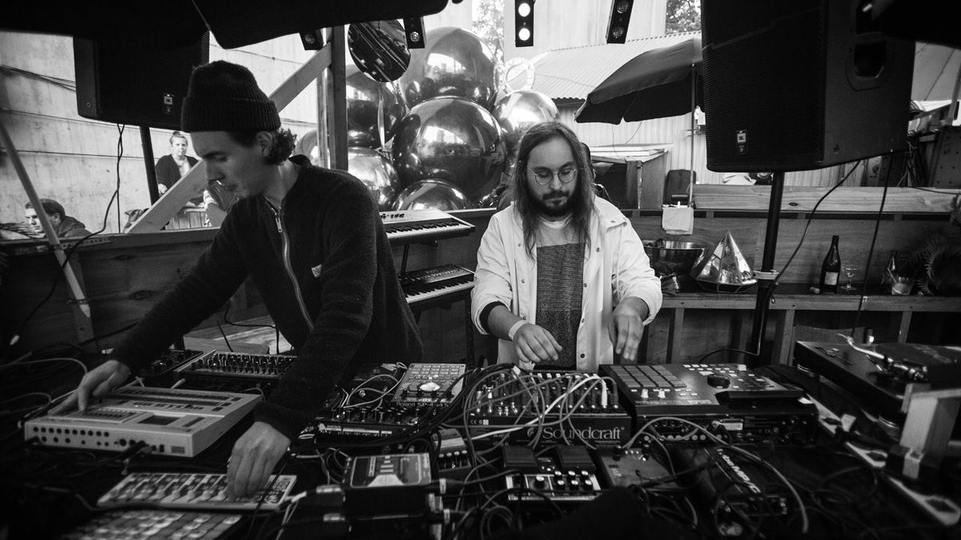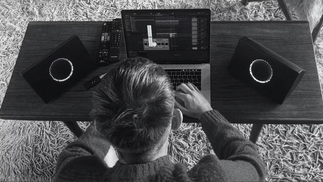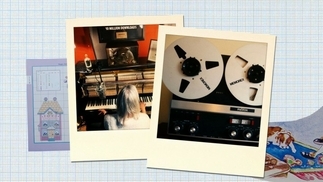Mount Liberation Unlimited: How I Play Live

Having found their musical feet playing in bands, it was a natural step for Mount Liberation Unlimited to take their new-found love for electronic music on the road in flight cases rather than USB ones. Their disco and house sound coupled with space-y warbled vocals and a lo-fi aesthetic combine to create winding and vivid records that bubble with personality. Their live show, as we found out, was a wild adventure in trial and error, one that continues to evolve along with the duos own ambitions. We caught up with them to find out how the show came together, the ethos behind the setup and what DJing can teach you about performing live...
What made you want to play live beyond just DJing?
"The way we entered the electronic music/dance scene was from a live-music background rather than a DJ one. We were just two guys that used to play in bands that started going to raves and got stuck in the dance. So our first approach to making electronic music was through the instruments we already knew rather than wanting to become DJs and play other people's music. Later on, when we started getting requests for gigs we weren’t really comfortable in playing records together yet, so the most natural and honest approach for us was to figure out a way of how to perform our own music live in a club environment. Now we’ve realised that the common starting point usually seems to be the other way around. That initial naïveté was and still is key to everything we do."
What were the biggest challenges in putting your live show together?
"First off, we had absolutely no idea of where to start! Like, if you want to start a band, maybe you go to a few shows and pretty soon you realise that drums, guitar and bass might be a good starting point. But it’s not like you go to a few rave parties and then figure out how to put together a live set. Everything was so alien, and no setup looks like the next one. It’s really an open field where you have to balance your artistry versus technological challenges."

"Artistically, the biggest challenges that we’re still battling today is making electronic machines behave in organic ways, step away from the 16-step sequencer and loops, as well as sonically have your music compete with already-mastered and heavy limited music coming out through CDJs. On a personal level, it’s an important lesson to understand your role in the club as a performer, you need to mould yourself and your music to the room.
"Hopefully, with the rise of tech companies developing new kit today, it’s probably a bit easier to get started. Enter pretty much any music shop and you can come out with a techno-starter-pack that won’t break your wallet, and after a few YouTube tutorials you should be able to make them LEDs swing."
"That initial naïveté was and still is key to everything we do"
What does your setup consist of?
"Niklas is handling the MPC 1000/MPC 2000XL as main drummers, a Yamaha DTX drum pad for live drumming – which we also use a lot for MIDI looping – conga drums and a bunch of other hand-held percussion and a Moog Minitaur for bass. Tom does more of the harmonic stuff from a [Roland] Juno-106, sometimes a Korg PolySix. But due to the lack of fully functional pieces of these two synthesizers around the world we’ve just started to travel with a Behringer DeepMind 12. Tom also plays the guitar as well as vocals.
"All of this is sent to an analogue Allen & Heath mixing desk, with a bunch of send effects on the aux channels and a bus-style compressor on the master."
What would you change about your setup if you could?
"We’d love to play live with an acoustic drum kit and more full-size keyboards one day, but unfortunately we live and perform in a world where low budgets, max weight on flights and microphone feedback in nightclubs are a reality.
"Usually, we fly with cables and adaptors in our pockets because our 23kg bags are already so maxed out! Actually, that should be added to your question about challenges – travelling with a live set is always a god damn challenge."
What do you think is behind the current rise in live electronic music, in both more artists playing live and more tech companies creating kit specifically for live?
"Guess you already answered that partly for yourself in the question. More user-friendly gear – more live performers! Somewhat of a positive feedback loop coming from vintage gear getting ridiculously expensive, companies realising the market is there and so on.
"There’s also less of a steep learning curve today as well as a way more equal and welcoming market. Electronic music gear is not surrounded and capitalised by all nerdy dudes anymore and has somewhat become a bit de-mystified which is great. You don’t need a PhD in electronics or computer science to understand how a [Korg] Volca works for an example. And if you go to a music shop today, there’s as many samplers and drum machines on display in the window as there are guitars and amps. So there’s no scare for anyone to test this gear out you know? Hoping to see this change continue and seep into the modular synth community as well, which still feels extremely beardy-male dominated.
"On the performing side, the DJ market is quite oversaturated today as well, to be honest, which might add to the equation of people wanting to do something different."
"We learn plenty about playing live from DJing and vice versa"
What are the creative limitations of playing live? Would you recommend alternating between DJing and live to keep things fresh?
"Yes, definitely! Alternating between the two has given us so much. We learn plenty about playing live from DJing and vice versa. It really is an incredibly reciprocal combo and it makes both parts feel a lot more interesting.
"Talking creative limitations is a tricky one. In one way you’re free to push any button, create any rhythm, chord or melody you want at any time. But in another way, you’ll always be limited by the gear you’re performing with. Another major limitation, as opposed to DJing, is usually the time-frame. Not many promoters would book a live act for an all-night-long and give them the opportunity to set the vibe for the entire room. Not saying it’s something we want to do or that it’d even be a particularly good idea. But playing live you’ll most always be constricted to 60-minute time slots, so you’re definitely not given the same space to play and explore with deeper dynamics as a DJ is. This makes performers a bit stressed from our experience as it usually pushes a lot of live sets to be heavy on the bang-for-buck factor."

Does a dance floor feel or appreciate the effort that goes into a 'live' set in your opinion?
"Most of the time – yes. It always depends on the venue and context though. As well as the culture surrounding the city and club. Playing a one-hour live set in a dark techno club where people just want to get lost and dance for 14 hours straight can be a tough challenge. You don’t want to be a disruption in someone’s trip, you want to enhance their experience. But this is also where the knowledge from the DJ-side of things come real handy. Playing live in a dance club you always need to have that little DJ mentality in your planning. As well as a dancer mentality!
"Overall you´re not a disruption though, but more a welcomed change in dynamics. Especially today with DJ sets getting shorter and shorter. So we usually try to use that as a strength, to give the dancefloor a re-ignition of new energy. And when you manage to catch the attention of the dancefloor and end up on the same wavelength as the room you can really end up with childish excitement from the dancers over them realising that the conga drum or vocal they hear exists in reality and is being performed at that very moment."
"Playing live in a dance club you always need to have that little DJ mentality in your planning"
What would be your advice for a producer wanting to take their music live?
"Think twice – it’s easier to make a living as a DJ. Nah, but try to crystallise your music from an outside perspective and pin down what actually is special and unique about it. That’s what you should focus on bringing to the speakers. Also, try to work with dynamics. Dynamics! Energy levels, progression. Avoid too many loops. Make it feel human and honest. And don’t forget to rehearse."
As the lines blur between what “live” is – running a drum machine alongside a DJ set, or a full-blown laptop-less hardware setup – what do you think is next for performance in the club?
"Hmm. First of all – blurred lines are great. More blur. Ah, we’re terrible at predicting the future really. What we hope for though is a continued challenging of the genre lines, less play-it-safe use of all this crazy technology we have today. And hopefully more focus on the music and less focus on the people playing it."
Mount Liberation Unlimited's self-titled album is out now on Studio Barnhaus





